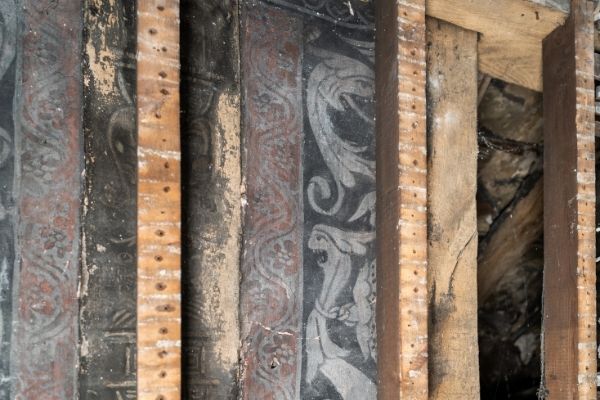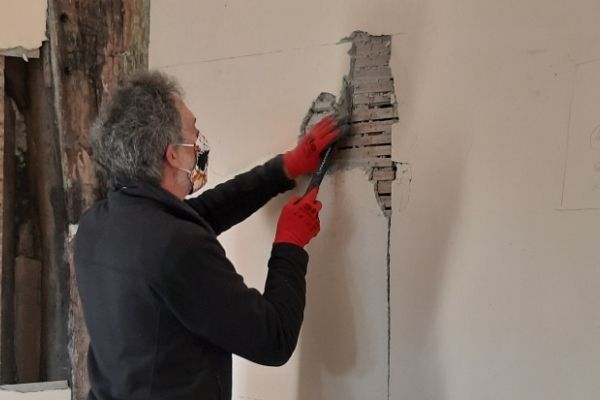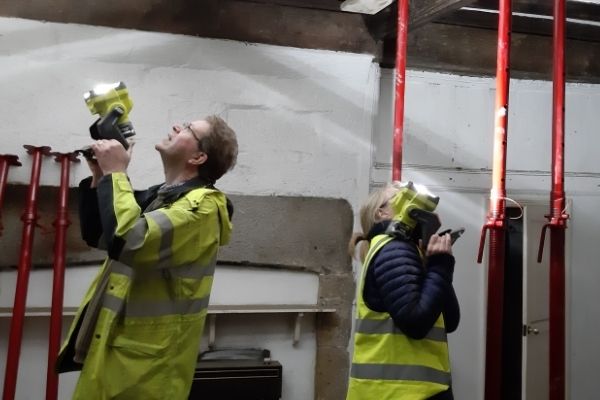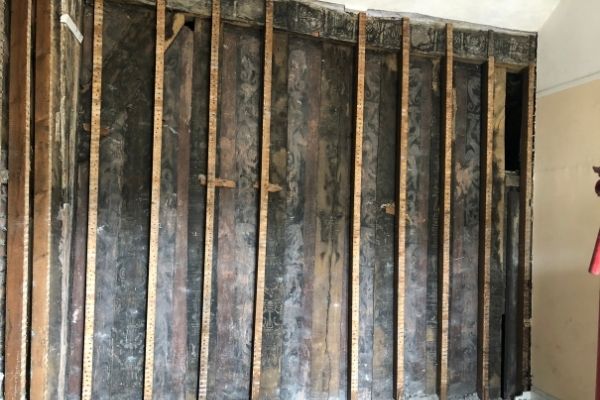We got the first inkling of something spectacular completely by accident. We were doing some preparatory ‘opening up’ at Calverley Old Hall, Yorkshire. Routine stuff before a big repair project, we were removing the small areas of plaster around the building to see whether the main joints of the great timber frame were still sound. One of the less interesting rooms was the upper chamber of the ‘Parlour block’, an unremarkable looking room with plain walls painted peach colour sometime in the 70s and a small 1930s fireplace.
 A close up of the figures.
A close up of the figures.
But there it was. An exposed area of timber seemed to have something on it. Or did it? We peered at it. Reddish, greenish, blackish stains on the oak. Was there something there? Or were they just the streaks and smudges of mould and dirt and decay? It looked likely to be wishful thinking that this was anything of note. But just on the off chance, ever cautious, we decided to ask the conservators at Lincoln conservation to have a look.
 A specialist from Lincoln Conservation opens up a section of wall.
A specialist from Lincoln Conservation opens up a section of wall.
Then came the thunderbolts. First, the Lincoln team removed the plaster in a further five small areas and revealed what we had not dared to hope: wall paintings. Black and white and ochre and red, clear and unmistakable wall paintings. Here a head, there a border, here a chevron, there a petal. We were speechless. It was clear at once that these almost certainly dated to the Tudor period. But still we only had specks. Five vivid pieces from a jigsaw of 500, we knew where they went but had no idea of the picture they made.
Later, the Lincoln team returned. Two days were allocated to them on site to remove the later plaster altogether and see how much remained beneath. I stopped in on the morning of day two, expecting them to have only just begun. When I walked up the stairs into the room I was simply overcome. The plaster had gone and there on all three walls before me was a revelation. Floor to ceiling, wall to wall, a complete, highly decorated Tudor chamber, stripped with black and red and white and ochre. Mythical creatures and twining vines, classical columns and roaring griffins.

Jonathan Clark, FAS Heritage and Linda Lockett, Landmark surveyor inspect the wall painting.
Wall paintings were prized in grand Tudor houses, and from time-to-time patches of them are revealed. But never in my own 27 years of working in historic buildings have I ever witnessed a discovery like this. Hidden panelling, yes, little snatches of decorative painting, once or twice. But an entire painted chamber absolutely lost to memory, a time machine to the age of the Reformation and the Virgin Queen, never.
 The exposed wall painting.
The exposed wall painting.
Lots of complex questions have now arisen. When exactly they were painted – according to our timber dating of the timber frame, it could be 1540s or perhaps more like 1580s - how best to preserve them, how to furnish and service a room with such spectacular surviving decoration. But their importance cannot be doubted. With them a slice of the lives of our ancestors has been restored to us, and nothing comes close to that.
A detailed history of the wall paintings